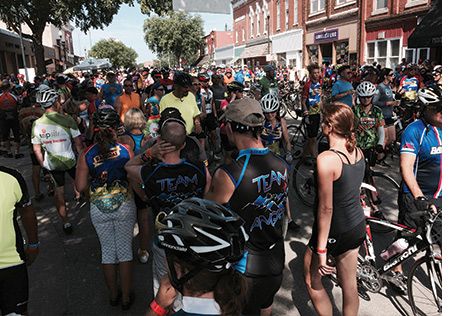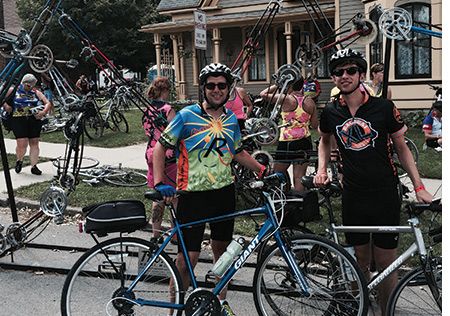Viewing Iowa’s conservation progress from a bicycle seat
Author
Published
7/28/2015
OK, I survived my first RAGBRAI. Last year I rode a few days, but this year I pedaled the entire route, some 462 miles from the Missouri River at Sioux City to the Mississippi River at Davenport. My leg muscles and a few other body parts are definitely still a little sore and I’m nursing a bit of a sunburn. But I’m glad I made the entire ride this year.
 Riding RAGBRAI is just a great way to experience Iowa. Traveling slowly (my preferred pace) is a perfect way to check out the progress and health of the corn, soybeans and hay crops. You get a real feel of the small towns and larger cities along the route and see the pride in Iowa’s iconic communities, such as Storm Lake, Eldora and Mount Vernon. And, best of all, you experience hospitality of rural Iowans that you feel all along the way. At nearly every farm and in most small towns, cheerleaders of all ages encouraged the 20,000 plus riders to keep pumping along, no matter the heat, humidity or hills.
Riding RAGBRAI is just a great way to experience Iowa. Traveling slowly (my preferred pace) is a perfect way to check out the progress and health of the corn, soybeans and hay crops. You get a real feel of the small towns and larger cities along the route and see the pride in Iowa’s iconic communities, such as Storm Lake, Eldora and Mount Vernon. And, best of all, you experience hospitality of rural Iowans that you feel all along the way. At nearly every farm and in most small towns, cheerleaders of all ages encouraged the 20,000 plus riders to keep pumping along, no matter the heat, humidity or hills.
Riding RAGBRAI also gave me a good chance to get a first-hand look at Iowa farmers’ continuing work to improve water quality through the Iowa Water Quality Initiative. Although the progress was probably lost on the majority of RAGBRAI riders who were focused on finding the best rhubarb pie on the route, it was very encouraging to me.
We rode past terraces, grassed waterways and other conservation structures designed to reduce nutrient and soil loss in the hilly country east of Sioux City. In the flatter center section of the state (an area that my aching legs very much appreciated) we cruised past a number of great looking wetlands, a critical tool for improving surface water quality, and more buffer strips than I could count. And when we got to the east, it was back to terraces and other structures that work well on hilly terrain to reduce nutrient loss.
Even though it was not visible, we pedaled past a farm near Webster City where I’d watched technicians install a bioreactor a few years ago to filter nitrates out of water coming from drainage systems. And south of Waterloo, we huffed past a saturated buffer demonstration project that I saw installed earlier this year, an innovative tool to keep the nutrients out of lakes and streams.
 This fall, I know that a lot of fields we rode past will be planted with cover crops, as farmers work to keep nitrogen and other nutrients in place.
This fall, I know that a lot of fields we rode past will be planted with cover crops, as farmers work to keep nitrogen and other nutrients in place.
All in all farmers have invested more than $100 million in the initiative to improve water quality in the two short years since it launched. That’s no small change, even though naysayers, like Des Moines Water Works CEO Bill Stowe, snub their noses at it.
Progress, like my RAGBRAI ride, takes time. I wish more people took the time to get out and see what’s going on. It sure looked impressive from a bicycle seat.
By Dirck Steimel. Dirck is News Services Manager at the Iowa Farm Bureau Federation.
 Riding RAGBRAI is just a great way to experience Iowa. Traveling slowly (my preferred pace) is a perfect way to check out the progress and health of the corn, soybeans and hay crops. You get a real feel of the small towns and larger cities along the route and see the pride in Iowa’s iconic communities, such as Storm Lake, Eldora and Mount Vernon. And, best of all, you experience hospitality of rural Iowans that you feel all along the way. At nearly every farm and in most small towns, cheerleaders of all ages encouraged the 20,000 plus riders to keep pumping along, no matter the heat, humidity or hills.
Riding RAGBRAI is just a great way to experience Iowa. Traveling slowly (my preferred pace) is a perfect way to check out the progress and health of the corn, soybeans and hay crops. You get a real feel of the small towns and larger cities along the route and see the pride in Iowa’s iconic communities, such as Storm Lake, Eldora and Mount Vernon. And, best of all, you experience hospitality of rural Iowans that you feel all along the way. At nearly every farm and in most small towns, cheerleaders of all ages encouraged the 20,000 plus riders to keep pumping along, no matter the heat, humidity or hills.
Riding RAGBRAI also gave me a good chance to get a first-hand look at Iowa farmers’ continuing work to improve water quality through the Iowa Water Quality Initiative. Although the progress was probably lost on the majority of RAGBRAI riders who were focused on finding the best rhubarb pie on the route, it was very encouraging to me.
We rode past terraces, grassed waterways and other conservation structures designed to reduce nutrient and soil loss in the hilly country east of Sioux City. In the flatter center section of the state (an area that my aching legs very much appreciated) we cruised past a number of great looking wetlands, a critical tool for improving surface water quality, and more buffer strips than I could count. And when we got to the east, it was back to terraces and other structures that work well on hilly terrain to reduce nutrient loss.
Even though it was not visible, we pedaled past a farm near Webster City where I’d watched technicians install a bioreactor a few years ago to filter nitrates out of water coming from drainage systems. And south of Waterloo, we huffed past a saturated buffer demonstration project that I saw installed earlier this year, an innovative tool to keep the nutrients out of lakes and streams.
 This fall, I know that a lot of fields we rode past will be planted with cover crops, as farmers work to keep nitrogen and other nutrients in place.
This fall, I know that a lot of fields we rode past will be planted with cover crops, as farmers work to keep nitrogen and other nutrients in place.
All in all farmers have invested more than $100 million in the initiative to improve water quality in the two short years since it launched. That’s no small change, even though naysayers, like Des Moines Water Works CEO Bill Stowe, snub their noses at it.
Progress, like my RAGBRAI ride, takes time. I wish more people took the time to get out and see what’s going on. It sure looked impressive from a bicycle seat.
By Dirck Steimel. Dirck is News Services Manager at the Iowa Farm Bureau Federation.